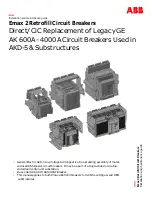
1 0.4.3 FALSE TRIPPING-BREAKERS
EQUIPPED WITH GROUND FAULT
When nuisance tripping occurs on breakers equipped
with the Ground Fault trip element, a probable cause is the
existence of a false "ground" signal. As indicated by the
cabling diagram of Fig.
69,
each phase sensor is con
nected in a series with a primary winding on the Ground
Fault differential transformer. Under no-fault conditions on
3-wire load circuits, the currents in these three windings
add to zero and no ground signal is developed. This current
sum will be zero only if all three sensors have the same
electrical characteristics. If one sensor differs from the
others (i.e., different rating or wrong tap setting), the dif
ferential transformer can produce output sufficient to trip
the breaker. Similarly, discontinuity between any sensor
and the programmer unit can cause a false trip signal.
If nuisance tripping is encountered on any breaker
whose SST components have previously demonstrated
satisfactory performance via the TAK-TS1 Test Set, the
sensors and their connections should be closely
scrutinized. After disconnecting the breaker from all power
sources,
a) Check that all phase sensors are the same type (am
pere range).
b) Ensure that the tap settings on all 3-phase sensors
are identical.
1 0.5 SST CABLING DIAGRAMS
c) Verify that the harness connections to the sensors
meet the polarity constraints indicated by the cabling dia
gram, i.e., white wire to COMMON, black wire to TAP.
d) On Ground Fault breakers serving 4-wire loads,
check that the neutral sensor is properly connected (see
cabling diagram Fig.
70).
In particular,
( 1 ) Verify that the neutral sensor has the same rating
and tap setting as the phase sensors.
(2)
Check continuity between the neutral sensor and its
equipment-mounted secondary disconnect block. Also
check for continuity from the breaker-mounted neutr;il
secondary disconnect block through to the female harness
connector (terminals L and N).
(3) If the breaker's lower studs connect to the supply
source, then the neutral sensor must have its LOAD end
connected to the source.
(4) Ensure that the neutral conductor is carrying only
that neutral current associated with the breaker's load cur
rent (neutral not shared with other loads).
e) lf the preceding steps fail to identify the problem, then
the sensor resistances should be measured. Since the
phase and neutral sensors are electrically identical, their
tap-to-tap resistance should closely agree. See Table 8.
FLUX SHIFT
TRIP
DEVICE
PROGRAMMER
UNIT
�-- - -- -
LOAD
(48V. del
ANOOE)
HARNESS
PROGRAMMER
CONNECTOR
CONNECTOR
(AMP 201298·1 ) (AMP 201297·1)
FIG. 68
- CABLING DIAGRAM - SST WITHOUT G ROUND FAULT
53
www
. ElectricalPartManuals
. com
















































